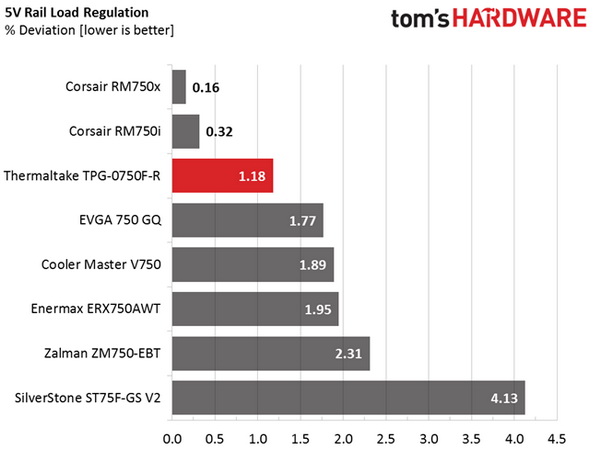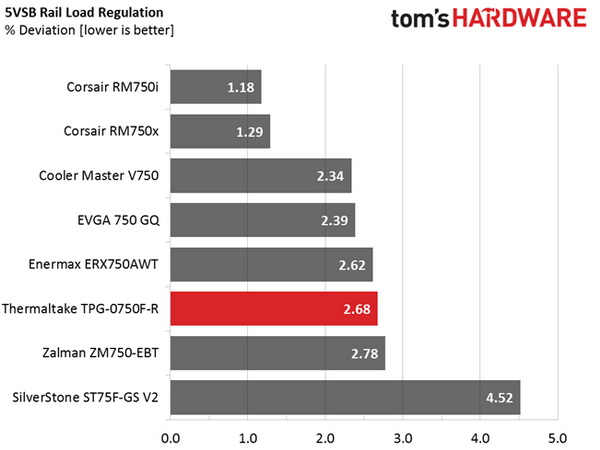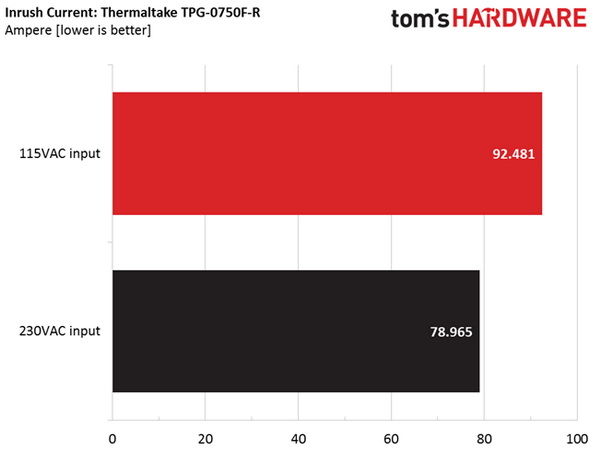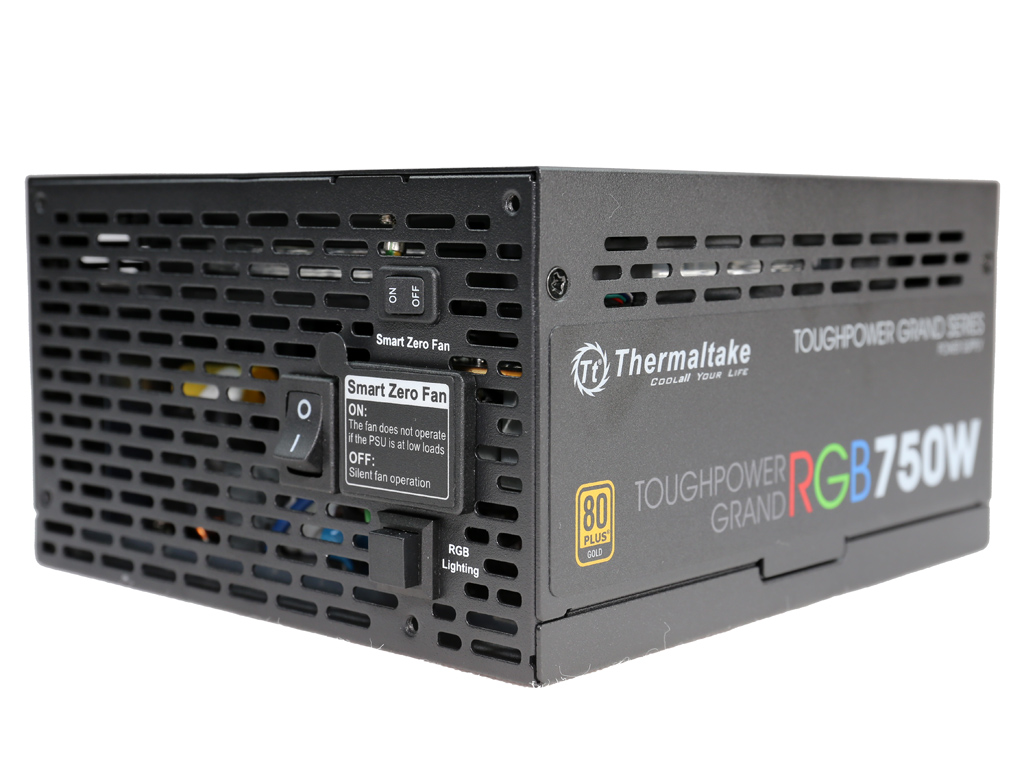Thermaltake Toughpower Grand RGB 750W PSU Review
RGB LED lighting is the new hotness, and a lot of power supplies are incorporating it. Thermaltake's Toughpower Grand RGB with 750W of maximum power boasts RGB lighting, surprisingly good performance, and modular cabling.
Why you can trust Tom's Hardware
Load Regulation, Hold-Up Time, And Inrush Current
To learn more about our PSU tests and methodology, please check out How We Test Power Supply Units.
Primary Rails And 5VSB Load Regulation
Load Regulation testing is detailed here.








Hold-Up Time
Our hold-up time tests are described in detail here.







The hold-up time we measured exceeds 17ms, but the power-good signal lasts for less than 16ms. We'll still give the TPG-0750F-R a pass since its power-good signal is accurate and only a hair away from the ATX specification's minimum duration.
Inrush Current
For details on our inrush current testing, please click here.


Observed inrush current is very high because the PSU lacks an NTC thermistor for limiting high start-up currents.
Load Regulation And Efficiency Measurements
The first set of tests reveals the stability of the voltage rails and the TPG-0750F-R's efficiency. The applied load equals (approximately) 10 to 110 percent of the PSU's maximum load in increments of 10 percentage points.
Get Tom's Hardware's best news and in-depth reviews, straight to your inbox.
We conducted two additional tests. During the first, we stressed the two minor rails (5V and 3.3V) with a high load, while the load at +12V was only 0.1A. This test reveals whether a PSU is Haswell-ready or not. In the second test, we determined the maximum load the +12V rail could handle with minimal load on the minor rails.
| Test # | 12V | 5V | 3.3V | 5VSB | DC/AC (Watts) | Efficiency | Fan Speed | Fan Noise | Temps (In/Out) | PF/AC Volts |
|---|---|---|---|---|---|---|---|---|---|---|
| 1 | 4.354A | 1.962A | 1.967A | 0.986A | 74.784 | 88.807% | 0 RPM | 0 dB(A) | 41.88°C | 0.970 |
| 12.224V | 5.088V | 3.350V | 5.058V | 84.210 | 39.03°C | 115.15V | ||||
| 2 | 9.746A | 2.948A | 2.961A | 1.185A | 149.750 | 90.984% | 1240 RPM | 39.9 dB(A) | 38.73°C | 0.986 |
| 12.201V | 5.079V | 3.339V | 5.045V | 164.589 | 41.25°C | 115.13V | ||||
| 3 | 15.506A | 3.453A | 3.477A | 1.391A | 224.948 | 91.982% | 1290 RPM | 40.2 dB(A) | 39.01°C | 0.995 |
| 12.180V | 5.070V | 3.330V | 5.032V | 244.557 | 41.85°C | 115.06V | ||||
| 4 | 21.266A | 3.946A | 3.971A | 1.590A | 299.747 | 91.859% | 1295 RPM | 40.3 dB(A) | 39.68°C | 0.997 |
| 12.160V | 5.064V | 3.321V | 5.020V | 326.312 | 42.72°C | 115.21V | ||||
| 5 | 26.708A | 4.946A | 4.980A | 1.797A | 374.752 | 91.399% | 1335 RPM | 41.5 dB(A) | 40.67°C | 0.996 |
| 12.140V | 5.059V | 3.312V | 5.009V | 410.016 | 43.64°C | 115.05V | ||||
| 6 | 32.168A | 5.930A | 5.996A | 1.998A | 449.667 | 90.796% | 1405 RPM | 42.7 dB(A) | 42.22°C | 0.996 |
| 12.121V | 5.054V | 3.302V | 5.000V | 495.249 | 46.00°C | 115.06V | ||||
| 7 | 37.651A | 6.935A | 7.013A | 2.200A | 524.664 | 90.125% | 1435 RPM | 42.9 dB(A) | 42.73°C | 0.997 |
| 12.100V | 5.049V | 3.293V | 4.990V | 582.154 | 47.54°C | 115.22V | ||||
| 8 | 43.142A | 7.930A | 8.039A | 2.407A | 599.569 | 89.342% | 1450 RPM | 43.5 dB(A) | 43.65°C | 0.997 |
| 12.081V | 5.043V | 3.283V | 4.980V | 671.093 | 49.33°C | 115.26V | ||||
| 9 | 49.090A | 8.445A | 8.583A | 2.410A | 674.646 | 88.522% | 1450 RPM | 43.5 dB(A) | 44.59°C | 0.998 |
| 12.060V | 5.036V | 3.274V | 4.975V | 762.126 | 51.47°C | 115.30V | ||||
| 10 | 54.798A | 8.952A | 9.097A | 3.033A | 749.475 | 87.610% | 1450 RPM | 43.5 dB(A) | 45.54°C | 0.998 |
| 12.040V | 5.029V | 3.263V | 4.947V | 855.468 | 53.75°C | 115.16V | ||||
| 11 | 61.127A | 8.970A | 9.123A | 3.035A | 824.401 | 86.652% | 1450 RPM | 43.5 dB(A) | 45.77°C | 0.998 |
| 12.019V | 5.020V | 3.255V | 4.939V | 951.388 | 54.97°C | 115.08V | ||||
| CL1 | 0.100A | 14.023A | 14.004A | 0.004A | 119.476 | 84.744% | 1380 RPM | 42.5 dB(A) | 42.82°C | 0.986 |
| 12.209V | 5.109V | 3.327V | 5.147V | 140.984 | 47.07°C | 115.09V | ||||
| CL2 | 62.453A | 1.002A | 1.002A | 1.002A | 764.988 | 88.188% | 1450 RPM | 43.5 dB(A) | 44.47°C | 0.998 |
| 12.036V | 5.012V | 3.282V | 4.983V | 867.450 | 52.10°C | 115.07V |
The load regulation we measured isn't up to TT's promises, that's for sure. We can't call it bad, though. The +12V and 5V rails do stay within 2% (the latter close to 1%, in fact), while 3.3V and 5VSB fall into the 3% range. Efficiency-wise, the TPG-0750F-R performs amazingly well for a Gold-rated unit. This is a nice surprise when we consider our previous experiences with Sirfa's platform.
Thermaltake's semi-passive mode doesn't last long, after which the fan starts spinning quickly under tough conditions. We would like to see a less aggressive fan profile in such an efficient PSU, but apparently Thermaltake wanted to play it safe. Thankfully the fan has a low maximum speed, so it isn't particularly noisy.
Current page: Load Regulation, Hold-Up Time, And Inrush Current
Prev Page A Look Inside And Component Analysis Next Page Efficiency, Temperature, And Noise
Aris Mpitziopoulos is a contributing editor at Tom's Hardware, covering PSUs.
-
shrapnel_indie Has anyone tested this claim of a cooler PC with the PSU fan facing up into the case instead of down and drawing air from outside?Reply
Edit: I see with at least this unit, it was found to be so, What about other units? -
Phillip Wager I have my computer case in a dusty area of my house and on the floor. i flipped my psu fan to face inside the case because i was sick of having to clean the dust filter every week or so. I'm paranoid about psu dust death. I have PLENTY of case fans(5) so i'm not worried about the psu overheating in this configuration.Reply -
Malik 722 but mounting power supply fan side up won't suck in hot air from the chassis and increase the power supply temperature.Reply -
Virtual_Singularity Reply19328496 said:I want it, for my Asus
Cool
Na, you really don't, you can do better methinks. -
blackmagnum "It's common knowledge that hot air rises, so if we want to improve airflow inside a chassis, we have to help move hot air up and out with fans installed on the top or back. We'll have to revisit this topic in a story about PSU orientation and its effect on case cooling."Reply
-I'll be looking forward to the article. -
SeoulFood I just won this PSU at a LAN this past weekend. I would use it, but I won a Silverstone 850w at the last LAN. Craigslist here we come.Reply


